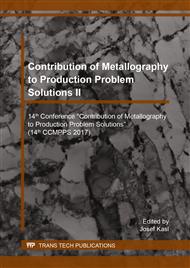p.34
p.39
p.45
p.52
p.57
p.63
p.68
p.74
p.80
Causal Analysis of Damage of a Cover
Abstract:
In this article, the causes of damage of a cover were investigated by metallographic and fractographic analysis. The component part was made from non-alloy quality steel for cold forming DC04. The failure occurred during high temperature pulsation (90 °C, 7b, 1 Hz) after 180,000 cycles. This component part was fabricated by deep drawing. After this process’s step, outlets were soldered at 1100 °C/5 min. to this part and then whole component part was coated using method without any specification. The coating layer was formed of Zn-Ni. The last step in this process was hemming where all component parts were assembled together. This case study was solved using light and scanning electron microscopy. The chemical composition was detected by energy dispersive X-ray analysis.
Info:
Periodical:
Pages:
57-62
Citation:
Online since:
November 2017
Price:
Сopyright:
© 2017 Trans Tech Publications Ltd. All Rights Reserved
Share:
Citation:


